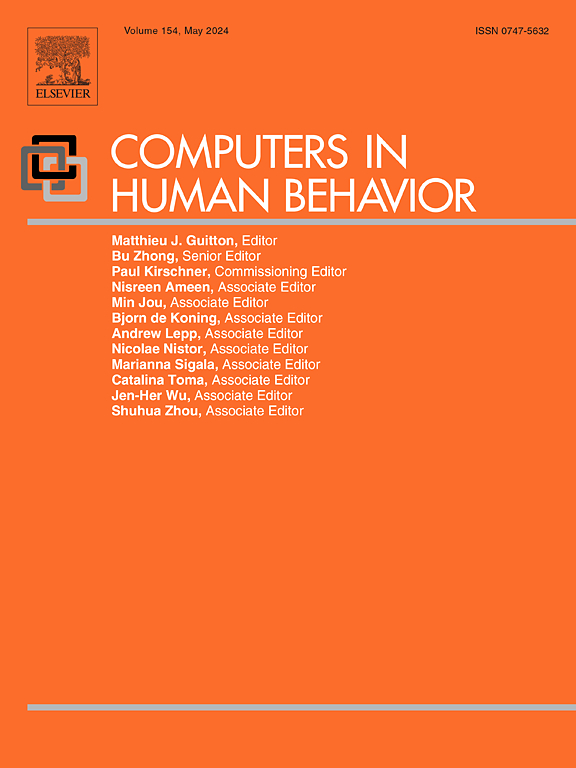Avatar-mediated communication in collaborative virtual environments: A study on users’ attention allocation and perception of social interactions
IF 9
1区 心理学
Q1 PSYCHOLOGY, EXPERIMENTAL
引用次数: 0
Abstract
Collaborative virtual environments (CVEs) facilitate avatar-mediated communication (AMC), where users interact using human-like virtual characters in shared virtual worlds, enhancing the attractiveness, attentiveness, and connectedness of remote social experiences and thus becoming extremely popular nowadays in various application domains such as education and healthcare. Understanding how different aspects of avatar behaviours influence various types of social interactions is crucial for improving the design of CVEs. Grounded in a theoretical framework based on avatar anthropomorphic realism, nonverbal social cues, eye-mind hypothesis, and interaction process analysis, this study investigates the impact of avatars’ gaze behaviours on users’ attention allocation and perceptions during AMC in CVEs. A two-arm randomised controlled trial (RCT) with 60 participants (29 males and 31 females) compared static gaze and natural gaze avatars during socio-emotional and task interactions. Three-dimensional eye-tracking data revealed distinct attention patterns across three primary nonverbal social cues: eye gaze, head orientation, and pointing gesture. Furthermore, avatars’ gaze type and interaction type were both found to significantly affect participants’ attention allocation; natural gaze behaviour and task interactions mitigated the general gaze-avoidance pattern observed in previous studies. However, avatars’ gaze type did not impact participants’ perceptions of social presence and anxiety. This research provides a nuanced understanding of attention allocation across nonverbal social cues during AMC and underscores the importance of avatars’ gaze and interaction types, highlighting important implications for the future design of CVE to enhance attention coordination and communication. Additionally, it calls for more comprehensive studies to explore avatars’ anthropomorphic realism and its effects on user perceptions and overall experience during AMC.
协作虚拟环境中虚拟角色中介交流:用户注意力分配与社交感知研究
协作虚拟环境(cve)促进了虚拟角色中介通信(AMC),用户在共享的虚拟世界中使用类似人类的虚拟角色进行交互,增强了远程社交体验的吸引力、注意力和连接性,因此在教育和医疗保健等各种应用领域中非常流行。了解化身行为的不同方面如何影响各种类型的社交互动,对于改进cve的设计至关重要。本研究基于虚拟化身拟人现实主义、非语言社会线索、眼心假说和互动过程分析等理论框架,探讨虚拟化身注视行为对虚拟情境下用户注意力分配和感知的影响。一项有60名参与者(29名男性和31名女性)参与的双臂随机对照试验(RCT)比较了静态凝视和自然凝视在社会情绪和任务互动中的作用。三维眼动追踪数据揭示了三种主要的非语言社交线索的不同注意模式:眼睛注视、头部方向和指向手势。此外,虚拟形象的凝视类型和互动类型都显著影响被试的注意力分配;自然凝视行为和任务互动减轻了先前研究中观察到的一般凝视回避模式。然而,虚拟形象的凝视类型并不影响参与者对社会存在和焦虑的感知。本研究提供了对AMC过程中非语言社交线索的注意分配的细致理解,并强调了虚拟角色的凝视和互动类型的重要性,强调了未来设计CVE以增强注意协调和沟通的重要意义。此外,还需要更全面的研究来探索角色的拟人化现实主义及其对AMC用户感知和整体体验的影响。
本文章由计算机程序翻译,如有差异,请以英文原文为准。
求助全文
约1分钟内获得全文
求助全文
来源期刊

Computers in Human Behavior
Multiple-
CiteScore
19.10
自引率
4.00%
发文量
381
审稿时长
40 days
期刊介绍:
Computers in Human Behavior is a scholarly journal that explores the psychological aspects of computer use. It covers original theoretical works, research reports, literature reviews, and software and book reviews. The journal examines both the use of computers in psychology, psychiatry, and related fields, and the psychological impact of computer use on individuals, groups, and society. Articles discuss topics such as professional practice, training, research, human development, learning, cognition, personality, and social interactions. It focuses on human interactions with computers, considering the computer as a medium through which human behaviors are shaped and expressed. Professionals interested in the psychological aspects of computer use will find this journal valuable, even with limited knowledge of computers.
 求助内容:
求助内容: 应助结果提醒方式:
应助结果提醒方式:


